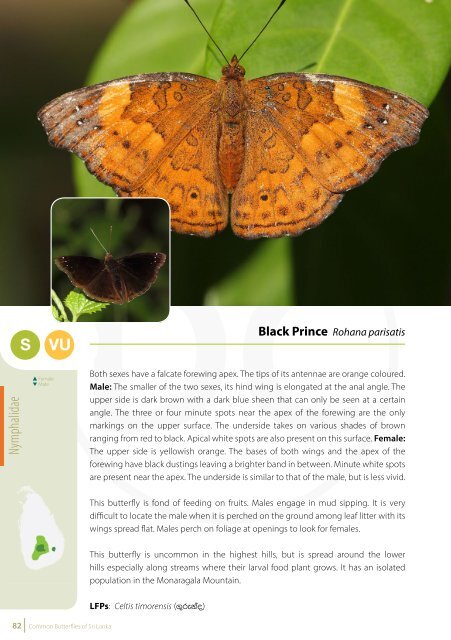Common Butterflies of Sri Lanka
Common Butterflies of Sri Lanka
Common Butterflies of Sri Lanka
You also want an ePaper? Increase the reach of your titles
YUMPU automatically turns print PDFs into web optimized ePapers that Google loves.
S<br />
VU<br />
Black Prince Rohana parisatis<br />
Nawab Polyura athamas<br />
M<br />
LC<br />
Nymphalidae<br />
Female<br />
Male<br />
Both sexes have a falcate forewing apex. The tips <strong>of</strong> its antennae are orange coloured.<br />
Male: The smaller <strong>of</strong> the two sexes, its hind wing is elongated at the anal angle. The<br />
upper side is dark brown with a dark blue sheen that can only be seen at a certain<br />
angle. The three or four minute spots near the apex <strong>of</strong> the forewing are the only<br />
markings on the upper surface. The underside takes on various shades <strong>of</strong> brown<br />
ranging from red to black. Apical white spots are also present on this surface. Female:<br />
The upper side is yellowish orange. The bases <strong>of</strong> both wings and the apex <strong>of</strong> the<br />
forewing have black dustings leaving a brighter band in between. Minute white spots<br />
are present near the apex. The underside is similar to that <strong>of</strong> the male, but is less vivid.<br />
This butterfly is fond <strong>of</strong> feeding on fruits. Males engage in mud sipping. It is very<br />
difficult to locate the male when it is perched on the ground among leaf litter with its<br />
wings spread flat. Males perch on foliage at openings to look for females.<br />
Females have much longer tails. The upper side is brownish-black with large sulphur<br />
yellow areas in the middle continuing through both wings. The two sub-apical spots,<br />
the row <strong>of</strong> sub-marginal spots on the hind wing and the tornal markings are the same<br />
colour. Its tails are dusted with a light blue tint. The underside takes on cryptic brown<br />
colours ranging from rosy brown basally to golden brown distally. Its sulphur yellow<br />
markings have a greenish hue and are outlined in black in the basal end. A band <strong>of</strong><br />
brownish red markings adjoin the yellow band on the hind wing. A black line runs<br />
across both cells and the forewing cell contains two black spots.<br />
The Nawab is a very fast butterfly, flying amongst trees in search <strong>of</strong> tree sap and fruits.<br />
It also comes to the ground for rotten fruits and eagerly feeds on toddy dribbled<br />
under Caryota urens (ls;=,a) trees. It feeds on the faecal matter <strong>of</strong> otters which contains<br />
the undigested parts <strong>of</strong> crabs and shrimps. They engage in ‘hill topping’ .<br />
Feeding on sweat on<br />
a camera strap<br />
Nymphalidae<br />
This butterfly is uncommon in the highest hills, but is spread around the lower<br />
hills especially along streams where their larval food plant grows. It has an isolated<br />
population in the Monaragala Mountain.<br />
LFPs: Celtis timorensis (.=rekao)<br />
The Nawab is not abundant, but is a regular in dry and intermediate zone forests<br />
along streams with exposed boulders where otters excrete.<br />
LFPs: Acacia caesia (ysÕ=re), A. pennata(f.dv ysÕ=re), Ventilago madraspatana (hlv<br />
je,a).<br />
82 <strong>Common</strong> <strong>Butterflies</strong> <strong>of</strong> <strong>Sri</strong> <strong>Lanka</strong><br />
<strong>Common</strong> <strong>Butterflies</strong> <strong>of</strong> <strong>Sri</strong> <strong>Lanka</strong> 83















